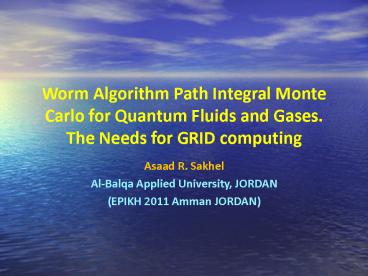Worm Algorithm Path Integral Monte Carlo for Quantum Fluids and Gases. The Needs for GRID computing - PowerPoint PPT Presentation
1 / 19
Title:
Worm Algorithm Path Integral Monte Carlo for Quantum Fluids and Gases. The Needs for GRID computing
Description:
Worm Algorithm Path Integral Monte Carlo for Quantum Fluids and Gases. The Needs ... (repulsive or attractive) on the properties of tunneling in optical lattices ... – PowerPoint PPT presentation
Number of Views:308
Avg rating:3.0/5.0
Title: Worm Algorithm Path Integral Monte Carlo for Quantum Fluids and Gases. The Needs for GRID computing
1
Worm Algorithm Path Integral Monte Carlo for
Quantum Fluids and Gases. The Needs for GRID
computing
- Asaad R. Sakhel
- Al-Balqa Applied University, JORDAN
- (EPIKH 2011 Amman JORDAN)
2
- Projects undertaken in the condensed matter group
of - Prof. Humam B. Ghassib (University of
Jordan, Amman) using Quantum Monte Carlo
techniques - Tunneling of Bosons in optical lattices (VMC
VPI) - (A. R. Sakhel et al., Phys. Rev. A 77,
043627 (2008)) - Microscopic investigations of the 3He- 4He
sandwich system on a graphite substrate (PIMC
Worm) - (Ghassib et al., submitted to Phys. Rev. E)
- Dynamics of Bose-Einstein condensates (future)
- (R. R. Sakhel et al., Phys. Rev. A 84, 033634
(2011))
3
Broad goals using other numerical methods
- VPI effects of interactions (repulsive or
attractive) on the properties of tunneling in
optical lattices, double wells. - WAPIMC thermodynamic properties of low
dimensional quantum fluids entropy, pressure,
internal energy, specific heat capacity. - Crank Nicolson dynamical evolution of
Bose-Einstein condensates
4
Microscopic Investigations of the 3He-4He
sandwich system on a graphite substrate
- The 3He-4He sandwich system consists of a 4He
layer ( 3.6 Å thick) , a 3He-4He mixture layer
(7- 11 Å) and a bulk 3He ( 11-12 Å) layer
5
Worm Algorithm (PIMCWorm)
- Worm Algorithm Monte Carlo (WAMC) is Path
Integral Monte Carlo (PIMC) using Worm updates
(Boninsegni et al., Phys. Rev. E 74, 036701
(2006)). Reference for PIMC is Ceperleys Rev.
Mod. Phys. 67, 279 (1995) - WAMC and PIMC particle is a trajectory in
space-time which closes upon itself after a
time ß1/kT. Each position in space-time
represented by a bead and the trajectory is
composed of a number of M beads - Particle trajectories are updated using open
configurations called worms.
6
Visualizing the Trajectories
- Imaginary time versus position (see also Ceperley
1995)
ß
7
Technical details
- Each bead is given an index and a name.
- Simulation space is divided into a number of
boxes (cells) labeled by arrays. The purpose is
then to identify the particles which lie within
these cells. - Extensive use of large arrays, e.g.
- hash(icell,it,ind)
- hash() gives particle name in cell icell, at
time it and for bead index ind. - Several subroutines which update the trajectories
of each particle Insert, Remove, Cut, Glue, Move
Forward Masha, Move Backward Masha, Move Forward
Ira, Move Backward Ira, etc. - Hard to parallelize for high performance computing
8
(No Transcript)
9
(No Transcript)
10
(No Transcript)
11
(No Transcript)
12
(No Transcript)
13
(No Transcript)
14
Resources needed for WAPIMC
- WAPIMC was written by Boninsegni et al. in
Fortran 90 and needs ifort compiler - No libraries needed. Code is self-contained
- High speed, 16 24 CPU Core 64 bit Workstations
for massive computation - Large RAM 32 GB (large arrays)
- Large storage gt 500 GB
- Long CPU computational time gt 3 months for each
WAPIMC run
15
Density matrix
- PIMC thermal density matrix (Ceperley 1995)
- is a set of
particle positions - PIMC is concerned with the evaluation of
statistical mechanical averages using Feynmans
path integral approach
16
- Integral of is divided into
time slices - Using
- Can then write density matrix using kinetic and
potential energy
17
- Simple action and interaction
- Action used in Metropolis algorithm (acceptance
criteria)
18
Conclusions
- The 3He-4He sandwich system on graphite is a
system which has been rarely investigated to the
best of our knowledge. Hence it would be
interesting to get GRID computing to explore
larger N. Currently use N 360. - GRID computing is severely needed to perform WAMC
calculations for many-body systems with N of
order 1000 and beyond.
19
Our collaborators and friends
- Nikolay Prokofev, UMass, Amherst MA, USA
- William J. Mullin, UMass, Amherst MA, USA
- Saverio Moroni, National Institute for the
Physics of Matter (INFM), Trieste, ITALY






























